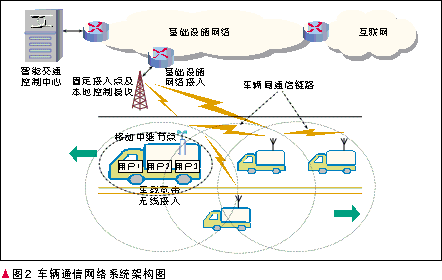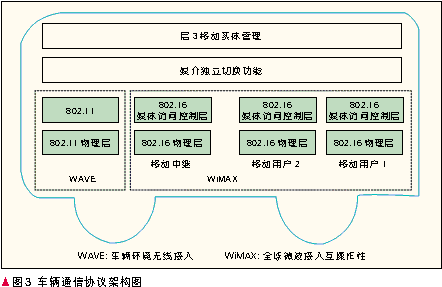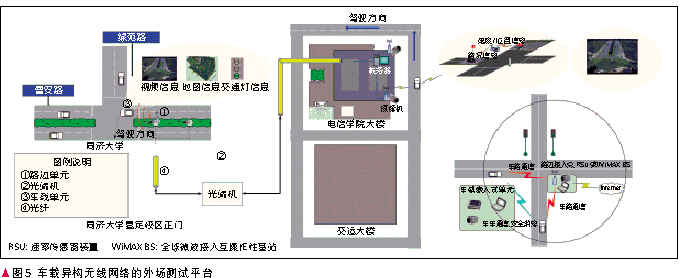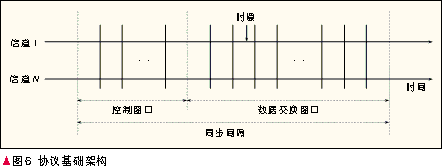The rapid development of computer technology, communication technology and microelectronic technology, as well as the mutual penetration and integration between the three have laid the application of communication network technology and promoted the development of social information. In recent years, the explosive growth of vehicles and the ubiquitous demand for information have increasingly integrated communication networks and vehicles. The demand for communication services in the process of vehicle movement is increasing. The research on vehicle mobile network has become the focus of the world, and it also promotes the development of vehicles in the direction of intelligence and networking.
This article refers to the address: http://
The traditional vehicle communication network is usually only a closed communication network designed for highway billing and other purposes. Recent developments have enabled the vehicle network to support the workshop to communicate independently and exchange safety information. Due to deficiencies in the network architecture, existing systems can only provide information exchange in local areas for vehicles at high speeds. The new generation of in-vehicle networks will provide ubiquitous services, including: a variety of vehicle safety messaging, intelligent traffic information services, multimedia digital services. Therefore, in the new generation of in-vehicle mobile networks, how to implement real-time data services between vehicles and intelligent traffic control centers (such as providing road condition information, map download services based on location information, etc.) and in-vehicle on the basis of ensuring inter-vehicle safety information intercommunication User broadband wireless access to the Internet to obtain multimedia entertainment, information and information has become a very important and urgent topic in the research of vehicle mobile networks. In response to this situation, the paper proposes a heterogeneous wireless network-integrated vehicle-mounted mobile network architecture, which is based on vehicle-based wireless access (WAVE) (IEEE802.11p) vehicle self-organizing communication technology and global microwave access interoperability. WiMAX (IEEE802.16e) in-vehicle broadband wireless access technology, and its key technologies are discussed and studied.
Research status and development trend of in-vehicle network communication
In recent years, vehicle communication networks have gradually become a hot issue in the field of Intelligent Transportation Systems (ITS). Countries are committed to applying advanced communication technologies to vehicle transportation systems to make them safer, smarter and more efficient. The Vehicle Self-Organizing Network (VANET) enables communication between vehicles (V2V) during the move, as well as communication between the vehicle and the roadside infrastructure (V2I) at low speeds or at rest, providing multiple safety applications for the vehicle and Non-secure applications. In 2004, the IEEE established the IEEE802.11p working group to develop the IEEE802.11 version of WAVE, and adopted the IEEE1609 series protocol as the upper layer protocol, thus forming the basic protocol framework for vehicle wireless communication [1]. A multi-channel test wireless Mesh network test bed was developed by Professor Nitin Vaidya, a professor at the University of Illinois at Urbana-Champaign. Professor UCLA G.Pau proposed the Special Routing Protocol between Vehicles (PVRP) and built a system test platform for verification. The University of Michigan, Guo Jinhua and Professor Wei Weidong developed a 5.9 GHz WAVE system channel test platform.
From the perspective of vehicle wireless access technology, most of the current mobile communication networks are based on IEEE802.11 communication technology, but 802.11 has a small coverage, and it is necessary to frequently switch the connection roadside unit and quality of service during vehicle movement. Support weaknesses that cannot provide high quality support for multimedia information [2-3]. To this end, we propose a study based on IEEE802.16 (which has a wide coverage and strong QoS support). Literature [4-5] proposes to use WiMAX (IEEE802.16)-based technology to carry out in-vehicle mobile broadband wireless access for vehicles and their internal users, and to apply WiMAX technology to vehicle communication networks for the first time. This idea essentially breaks the pattern of the IEEE802.11 unified vehicle communication network and opens up a new direction for the development and research of vehicle communication networks. Broadband wireless access systems based on the IEEE 802.16 technical standard have received wide attention in recent years. According to the results of actual network planning, WiMAX base stations have a reasonable coverage radius of several kilometers in urban areas, which can provide higher data. Transmission rate and wider coverage. In order to solve the problem of broadband wireless access in the case of high-speed mobile user terminals, the IEEE802.16 standard development group established a mobile relay (MRS) working group based on IEEE802.16j in March 2006 to study the feasibility of adopting MRS. I want to use the car MRS site to provide broadband wireless access services for group user terminals in the car [6].
At this stage, the research hotspots of in-vehicle mobile networks mainly focus on the multi-channel coordination application of vehicle communication based on WAVE protocol (IEEE802.11p), multicast routing management, and the switching of fixed relay technology based on WiMAX protocol (IEEE802.16). Resource scheduling.
In the self-organizing communication network between vehicles and vehicles based on the WAVE protocol, the secure and non-secure applications of the entire vehicle network are completed on one channel, and it is difficult to guarantee the QoS of the security application. Because a large amount of non-secure information may cause network congestion, the security message cannot be effectively transmitted, which seriously weakens the important role of VANET in active security. The use of multi-channel media access control (MAC) mechanism is one of the direct and effective methods to solve the above problems [7]. After multiple channels are used, different channels can be used for communication between nodes, and the access method is more flexible and changeable, and network throughput and delay characteristics superior to single channel can be obtained. For this situation, the time interval method is generally used to divide the time into control interval and data exchange interval [8-9]. At the control interval (CCH) all nodes hop to the control channel for channel negotiation, and then hop to the different channels for data transmission at the data exchange interval (SCH). The detailed architecture is shown in Figure 1.

.
The original routing mechanism in the WAVE protocol is not completely suitable for the in-vehicle communication network with dynamic topology changes. The table-driven proactive routing protocol cannot coordinate the nodes that are uncertain in the traffic environment, and the frequent changes of the topology seriously affect the performance of the protocol. The source-driven reactive routing protocol is established when the message needs to be sent. Routing will expire after a while. These routing protocols increase the number of communication hops and the speed of vehicle movement, and the delay in establishing routes is correspondingly increased, which makes it difficult to meet the low-latency security application, so location-based multicast routing occurs [10-11]. The goal of multicast routing is to pass messages from the source node to all nodes located in the associated area (ZOR). Aiming at the multicast routing mechanism, the concept of cluster is proposed, which organizes the vehicle network into multiple peer units (clusters), thus improving the scalability in the mobile environment [12]. In clustering mechanisms in VANET, intra-cluster communication can be used to deliver security-related emergency messages quickly and efficiently, while inter-cluster communication is used to deliver messages that need to reach more distant areas across multiple hops. This cluster-based routing method can provide full coverage of messages and low transmission delay, and is suitable for distributing various types of emergency messages while traveling. In the future, the clustering multicast routing concept will be utilized in the security application of the in-vehicle network. The cluster head acts as a coordinator. On the one hand, the security warning message is collected and distributed in real time in the cluster; on the other hand, the processed security message is forwarded to the neighbor cluster. head.
The communication between the vehicle and the roadside infrastructure is only adapted to the vehicle's low-speed or relatively static environment, and the vehicle is unable to provide long-term information interaction with the roadside unit's infrastructure during high-speed driving. In the vehicle broadband wireless access, an in-vehicle MRS station is introduced between the in-vehicle user terminal and the roadside base station to coordinate communication between the in-vehicle user and the base station, and the base station and the in-vehicle user terminal will perform signaling interaction through the MRS site. Instead of direct communication between the two.
In such a system, the concept of hierarchical scheduling and group movement has emerged. The information exchange between the base station and the in-vehicle user terminal is performed by the MRS, and the MRS obtains the allocated resources from the serving base station and the in-vehicle user from the in-vehicle relay, that is, the two-level resource scheduling. At the same time, after the introduction of the MRS node, the mobility management is improved a lot. The relay node can bundle the communication links of the same type of service with similar QoS requirements from the user terminals in the vehicle, and centrally process the group switching, reducing the number of The process of signaling interaction between each terminal user and the base station in the past handover process. Literature [13] proposed a two-level resource scheduling mechanism based on fixed relay, which improves the system throughput and reduces the packet loss rate and delay time of the service. Literature [14] proposed a technology for multi-hop cellular network relay-assisted handover. The mobile terminal transmits information through the relay node. This technology ensures the QoS parameters of the channel and reduces the dropped call rate. In [15], the MRS-based group switching is proposed for the first time. The mobile relay station assists the in-vehicle user terminal to complete the handover of the access target base station, and improves the handover success rate and reduces the handover blocking and delay by reallocating the resources during the handover. .
In summary, the WAVE protocol can provide real-time text and image information for road intersections, gas stations, parking lots, etc., with a communication speed of tens of megabits per second over a radius of several hundred meters, and the communication technology is also It can be used for vehicle workshop communication to provide emergency safety message communication for vehicles in motion to prevent vehicle collision. With a maximum communication radius of several kilometers, WiMAX can be used on high-speed mobile vehicles with a speed of more than 120km per hour, and the superior system gain of its MRS station can also provide higher-speed communication services for in-vehicle user terminals. Therefore, we propose an in-vehicle mobile network architecture that combines WiMAX and WAVE's new heterogeneous networks to form a vehicle mobile communication network for vehicle safety communication, traffic information transmission, and broadband wireless multimedia data transmission.
New vehicle 2 and the mobile communication network architecture reference model
2.1 network system architecture

In the heterogeneous fusion vehicle mobile network architecture proposed in the paper, the communication between vehicles and vehicles is realized by WAVE, and the communication between the vehicle and the roadside base station is realized by WiMAX. The MRS concept is also introduced in the two-layer structure of the vehicle user terminal and the roadside base station, and the in-vehicle user performs network communication through the MRS station. The detailed vehicle communication system network architecture is shown in FIG. 2 . The new vehicle communication network architecture supports emergency communication between vehicles to ensure active safety of vehicles; supports broadband wireless access for vehicles and in-vehicle user terminals through MRS stations, enabling real-time interaction with intelligent traffic control centers. Reliable information interaction, and can provide broadband wireless network access to the Internet for user terminals in the car to transmit multimedia data services. The new vehicle-mounted mobile heterogeneous wireless communication protocol architecture is shown in Figure 3. The inter-vehicle communication is based on IEEE802.11p local area network, which is realized by self-organizing method, providing reliable connection and emergency security message for workshop communication. Transmission, realizing security alarm and resource sharing between vehicles; vehicle broadband wireless access is based on IEEE802.16 metropolitan area network, which can access the current access base station through the MRS station, and the in-vehicle user terminal can be carried out through the vehicle MRS station. High-speed uploading and downloading, and users in the car form a group through the MRS station, so that overall handover can be realized at the cell edge.

.
2.2 Communication Protocol Module Model
Under the heterogeneous fusion of WAVE-based vehicle ad hoc communication technology and WiMAX-based in-vehicle broadband wireless access technology, the in-vehicle mobile network can ensure that the vehicle is different under the IEEE802.11 and IEEE802.16 multimode terminals during the mobile process. Kind of information delivery service. Because different types of networks have different MAC and high-level mobility management protocols, it is necessary to develop a media-independent switching technology between Layer 2 protocols and Layer 3 protocols to provide heterogeneous network switching services. We use the IEEE 802.21-based Media Independent Switching Function Module (MIHF) [16]. This kind of heterogeneous network convergence technology based on 3G, WiMAX, Wi-Fi and other protocols has great development prospects, including access network discovery and selection, handover initiation and power optimization under different types of networks. The performance is done with the assistance of the MIHF module. After adopting the MIHF module, the handover delay and handover loss rate of different broadband wireless access networks in the mobile process can be greatly improved. The network architecture hierarchy and module model of the whole system are shown in Fig. 4.

2.3 Communication field test platform
On-board mobile heterogeneous wireless network communication field test platform, based on the existing vehicle network system simulation test platform in the laboratory, can establish IEEE-based based on the field test scheme in two different scenarios: vehicle communication and vehicle communication. .16j Mobile WiMAX car broadband access network different service transmission and IEEE802.11pWAVE-based vehicle self-organizing network communication, and based on this analysis of its performance. The laboratory's in-vehicle network test field is located at the campus of Jiading Campus of Tongji University and Cao'an intersection. As shown in Figure 5, the test platform realizes high-speed transmission of safety information between vehicles, realizes information interaction with the intelligent traffic information center (such as: road condition indication), and also realizes digital multimedia service interaction with the public network (such as: Internet access). ).

3 Key Technology Research of New Vehicle Mobile Communication Network
The main purpose of the article is to conduct a new exploration of the new in-vehicle mobile communication network. From the perspective of the fusion of WAVE and WiMAX technologies, a feasible solution is proposed for the overall architecture of the vehicle communication network, and the design criteria and optimization methods of cross-layer convergence are used to improve the performance of the new vehicle communication network. The key research techniques of the new in-vehicle mobile communication network will be briefly introduced from the aspects of multi-channel coordination and scheduling, routing mechanism improvement, group switching and two-level resource scheduling.
3.1 Distributed channel scheduling and channel adaptive coordination mechanism based on link state
In the study of multi-channel, the paper adopts channel coordination mechanism based on slot interval and channel access mechanism of time division multiple access (TDMA) to determine the basic architecture of the protocol. In a synchronous protocol infrastructure comprises a control window interval and a data exchange windows, each time slot is further divided by. The control window is used to broadcast security messages and control messages. The data exchange window is used for unicast or regional broadcast of non-secure information. The framework of the designed VANET multi-channel MAC protocol is shown in Figure 6. The channel adaptive coordination mechanism based on traffic density mainly adjusts the control window interval and the data exchange window interval dynamically according to the traffic density information. Based on the proposed protocol framework, the distributed multi-channel scheduling algorithm is used to allocate optimal resources to nodes from the two-dimensional perspective of frequency and time in a local scope; improve channel utilization and throughput; Based on the whole network, the performance of the algorithm is analyzed.

3.2 Relative position based routing algorithm
In the current in-vehicle network, the relative position between the nodes can be obtained through link prediction, thereby routing selection. In order to reduce the burden on the data link layer, the current routing algorithm can be performed independently of the MAC. In the research, a global positioning system (GPS) device can be used to provide location information. By predicting the movement of the moving vehicle nodes and improving the existing clustering algorithm, the emergency message broadcast mechanism is used to ensure that the emergency message is sent quickly and stably after the vehicle has an accident. On this basis, it is very important to design a clustered broadcast routing algorithm based on mobile prediction. At the same time, due to the high-speed movement of vehicle nodes in the vehicle network, the network topology changes frequently. In order to improve the service quality of the vehicle network and alleviate the delay caused by the frequent interruption of the node during the network transmission, it is necessary to pass the position and velocity and acceleration of the node. The information is predicted, the connection hold time is estimated, and the route discovery process is started before the route breaks to ensure the QoS of the data transmission.
3.3 Group switching mechanism based on mobile relay technology
Group switching (GHO) is a handover of multiple user terminals on a mobile vehicle to the next base station. In the handover process, resource re-allocation needs to be performed according to different service levels to ensure QoS of services; The mobile user prediction technique can be used to perform preliminary estimation to reduce the call drop rate and reduce the handover delay. The research of group switching based on relay technology includes: group handover process design based on mobile prediction, handover admission control strategy based on subchannel reassignment strategy, and speed adaptive handover algorithm research.
3.4 Relay-based two-level scheduling algorithm
After the in-vehicle network introduces the relay technology, the relay node will be added in the broadband wireless access system. The base station and the user terminal will perform signaling interaction through the relay site instead of direct communication between the two. Therefore, in this system, the concept of hierarchical scheduling occurs, mainly the resource scheduling at the base station and the resource scheduling at the relay node, that is, a distributed scheduling mechanism is adopted. Since the relay station itself has strong processing capability, including partial base station decision capability, the relay node can assist the base station to make a corresponding decision on resource allocation optimization for the user terminal, thereby reducing the burden on the base station and improving the throughput of the system. Data transfer speed. The two-level resource scheduling algorithm mainly performs two-level dynamic bandwidth resource allocation (DBA) according to the network environment change under the three-layer structure of "vehicle-MRS node-roadside base station", providing spectrum resource utilization and providing for different types of services. Different quality of service guarantees.
.
4 Conclusion
In the "new generation broadband wireless mobile communication network" designated in the national "Eleventh Five-Year" scientific and technological development plan, the integration of vehicle self-organizing communication network and broadband wireless access network will be an important part. The new vehicle network can improve the service level of urban intelligent transportation system, promote the construction of urban broadband wireless information system, and provide strong support for the development of wireless cities and the construction of digital network cities. Aiming at this situation, this paper proposes a WAVE-based vehicle self-organizing communication network and a hybrid vehicle-mounted mobile network architecture based on WiMAX-based vehicle broadband wireless access technology, and presents a protocol module model for the new vehicle mobile network. In the process of designing a new vehicle-mounted mobile network protocol framework, we have key technologies such as multi-channel coordination, scheduling, multicast routing mechanism, group switching in vehicle broadband wireless access, and multi-level resource scheduling and distribution mechanism in vehicle self-organizing communication. Theoretical research has been carried out. In the system design of the new in-vehicle mobile network in the future, a series of technologies such as QoS guarantee for communication services in high-speed mobile scenarios and fast and seamless handover under heterogeneous network coverage in the mobile process have yet to be further studied.
5 References
[1]ASTME2213-03.Standardspecificationfortelecommunicationsandinformationexchangebetweenroadsideandvehiclesystems-5GHzbanddedicatedshortrangecommunication(DSRC)mediumaccesscontrol(MAC)andphysicallayer(PHY)specifications[S].2003.
[2] YINJijun, ELBATTT, YEUNGG, etal. PerformanceevaluationofsafetyapplicationsoverDSRCvehicularadhocnetworks[C]//Proceedingsofthe1stACMInternationalWorkshoponVehicularAdHocNetworks(VANET'04),Oct1,2004,Philadelphia,PA,USA.NewYork,NY,USA:ACM,2004:1-9.
[3] IEEEStd802.16e. IEEEstandardforlocalandmetropolitanareanetworks, Part16: Airinterfaceforfixedandmobilebroadbandwirelessaccesssystems[S].2006.
[4] YANGK, OUS, CHENH, etal. Amultihoppeercommunicationprotocolwithfairnessguaranteefor IEEE802.16basedvehicularnetworks[J]. IEEETransactionsonVehicularTechnology, 2007, 56(6): 3358-3370.
[5]SHANL,LIUF,YANGK.PerformanceanalysisofgrouphandoverschemeforIEEE802.16j-enabledvehicularnetworks[C]//ProceedingsofthetheJointInternationalConferencesonAsia-PacificWebConferenceandWeb-AgeInformationManagement(APWEB-WAIM'09),Apr5-7,2009,Suzhou,China.LNCS5446.Berlin,Germany:Springer- Verlag, 2009: 651-656.
[6] IEEEC802.16j-D5.Draftamendmentforlocalandmetropolitanareanetworks, Part16: Airinterfaceformobilebroadbandwirelesssystemsmultihoprelayspecification[S].2008.
[7] CRICHIGNOJ, WUMINyou, SHUWei.Protocolsandarchitecturesforchannelassignmentinwirelessmeshnetworks[J].AdHocNetworks,2008,6(7):1051-1077.
[8] MOJ, SOHW, WALRANDJ. Comparison of multichannel MAC protocols [J]. IEEE Transactionson Mobile Computing, 2008, 7(1): 755-765.
[9]SOHW, WALRANDJ, MOJ.Amulti-channelMACproposalforadhocwirelessnetworks[C]//ProceedingsofIEEEWirelessCommunications and NetworkingConference(WCNC'07), Mar11-15, 2007, HongKong, China. Piscataway, NJ, USA: IEEE, 2007: 255-260.
[10] LOCHERTC.Aroutingstrategyforvehicularadhocnetworksincityenvironments[C]//ProceedingsoftheIEEEIntelligentVehiclesSymposium(IVS'03), Jun9-11, 2003, Columbus, OH, USA. Piscataway, NJ, USA: IEEE, 2003: 156-161.
[11] KORKMAZG, EKICIE, OZGUNERF. Urbanmulti-hopbroadcastprotocolforinter-vehiclecommunicationsystems [C]//Proceedingsofthe1stACMInternationalWorkshoponVehicularAdHocNetworks (VANET '04), Oct1, 2004, Philadelphia, PA, USA. New York, NY, USA: ACM, 2004: 76-85.
[12] LIFan, WANGYu.Routinginvehicularadhocnetworks: Asurvey [J] .IEEEVehicularTechnologyMagazine, 2007,2 (2): 12-22.
[13] WANGLiping, JIYusheng, LIUFuquang.AdaptivesubframepartitioningandefficientpacketschedulinginOFDMAcellularsystemswithfixeddecode-and-forwardrelays [J] .IEICETransactionsonCommunications, 2009, E92-B (3): 755-765.
[14] JEONSH, LEESH.Arelay-assistedhandovertechniquewithnetworkcodingovermulti-hopcellularnetworks [J] .IEEECommunicationsLetters, 2007,11 (3): 252-254.
[15] SHANLianhai, LIUFuqiang, WANGLiping, etal.Predictivegrouphandoverschemewithchannelborrowingformobilerelaysystems [C] // ProceedingsoftheIEEEInternationalConferenceonWirelessCommunicationsandMobileComputing8,2008, CreteIsland, Greece (Conference (IWCMC'08), Aug6Piscataway, NJ, USA:. IEEE, 2008: 153-158.
[16] IEEEP802.21/D01.00. IEEEstandardforlocalandmetropolitanareanetworks:Mediaindependenthandoverservices[S].2006.
Oil filters have been popular among enthusiast and professionals alike for its great value and great contributions in boosting engine power. Due to the demands of application tested technology for performance enhancements, Oil Filter upgrades or performance oil filters have been included in most popular vehicle specifications to achieve the best possible fuel economy ever developed for all engine types. By letting your engine consume fuel at its finest form, wastage is minimized and overall output is substantially increased. Keeping the part in good working condition is necessary to ensure smooth operations while maintaining engine precision that enabling you to continually rake performance and fuel efficiency gains. Because the your fuel reservoir may have debris and rust particles, your engine oil filter works in isolating the debris and other contaminants so it would not reach your engine systems and clog engine channels which often results to leakage and more serous engine problems. Newer versions of this engine component feature thicker canister walls to establish strength offering long lasting and reliably efficient service. Ideal for ever demanding high performance driving applications, their high grade and extremely durable construction sustains smooth operations over extreme pressure and heat minimizing the risks of failure. Investing with quality and heavy duty oil filter makes a great valued investment that unleashes your vehicle full potential to achieve the best possible fuel economy your vehicle could deliver. By keeping the gains of precision flow of cleaner oil at faster rate due to consistent pressure, reaching peak combustion efficiency is conveniently possible. Thanks to the continuously increasing fuel rates, the need to consider fuel economy has been emphasized. Our site covers your general automotive needs as we carry a wider selection for heavy duty stock or performance oil filter replacements available for specific vehicle applications. Go on and seal your oil filter deals with us to order your needs right at your fingertips
Car manufacturers often suggest changing oil filters every other time you have your oil changed. Most parts and oil manufacturers, however, say to replace oil filters with every oil change, which should occur every 3,000 miles or three months (whichever comes first).
Oil Filter
Automotive Oil Filter,Car Oil Filter,Free Metal Oil Filter,Oil Filter Cartridge
Donguan Bronco Filter Co., Ltd , https://www.broncofilter-cn.com
